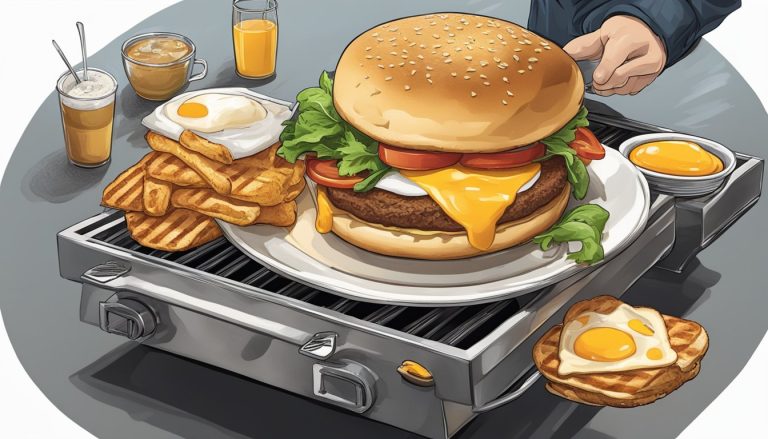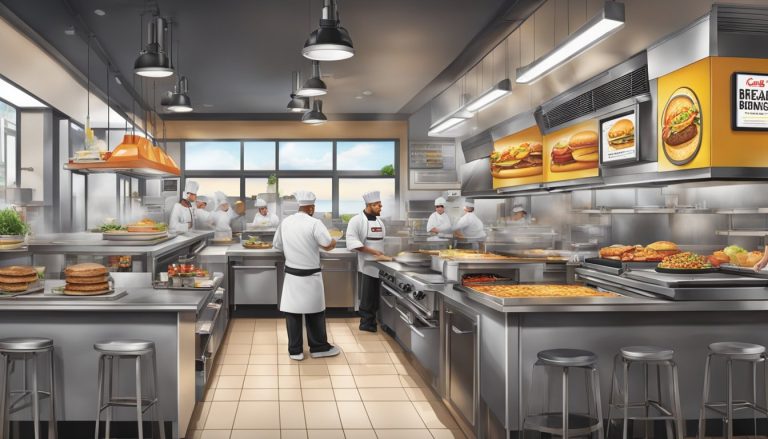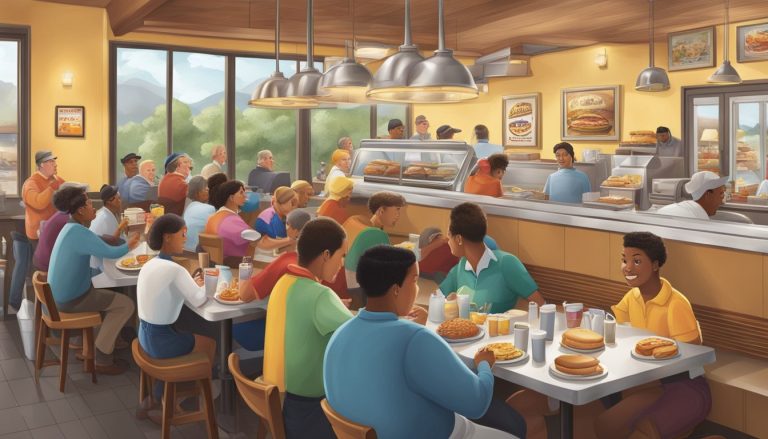Carl’s Jr., a prominent fast-food chain, has tapped into the power of scent marketing to entice breakfast customers. The aroma of freshly brewed coffee and sizzling bacon wafting through the air serves as an invisible yet potent advertisement, drawing in hungry patrons.
Carl’s Jr. strategically uses scent to create a welcoming atmosphere and trigger positive associations with their breakfast offerings. This olfactory approach complements their visual marketing efforts, engaging customers on multiple sensory levels. The carefully curated breakfast scents not only stimulate appetite but also evoke feelings of comfort and satisfaction.
By leveraging the connection between smell and memory, Carl’s Jr. aims to create lasting impressions that keep customers coming back. The enticing aromas of their breakfast menu items act as a powerful motivator, encouraging early morning diners to step inside and indulge in a hearty meal to start their day.
Evolution of Carl’s Jr. Brand

Carl’s Jr. began in 1941 when Carl Karcher and his wife started a hot dog cart in Los Angeles, California. This humble beginning laid the foundation for what would become a major fast-food chain.
In the 1950s, Carl introduced the “Carl’s Jr.” burger, marking the start of the brand’s expansion. The company grew rapidly throughout the 1960s and 1970s, spreading across the West Coast and adding charbroiled burgers to its menu.
The 1980s saw Carl’s Jr. venture beyond California’s borders. During this time, they launched the Western Bacon Cheeseburger, which quickly became a fan favorite. The brand’s iconic Happy Star logo also emerged, becoming synonymous with the chain.
Carl’s Jr. continued to innovate in the 1990s and 2000s. They introduced premium menu items like the Six Dollar Burger and formed a partnership with Green Burrito. This collaboration allowed Carl’s Jr. to tap into new markets and expand its brand presence.
Today, Carl’s Jr. is known for its “Larger than Life Personality” and “Burgers Built to Spill.” The brand focuses on creating a “Crave Culture” centered around their big, juicy Angus Thickburgers, Hand-Breaded Chicken Tenders, and Hand-Scooped Ice Cream Shakes.
Importance of Breakfast in Fast Food Industry
The fast food industry recognized breakfast as a crucial market segment in the early 1970s. McDonald’s pioneered this trend by introducing their first breakfast menu items, sparking a revolution in the sector.
Breakfast offerings quickly became a key revenue driver for fast-food chains. The morning meal provided an opportunity to capture customers at the start of their day, potentially increasing overall sales and brand loyalty.
Fast-food restaurants found that breakfast items often had higher profit margins compared to lunch and dinner options. This made the breakfast market particularly attractive for chains looking to boost their bottom line.
Carl’s Jr. entered the breakfast scene in 2004 with their iconic Breakfast Burger. This innovative item blurred the lines between traditional breakfast and lunch fare, appealing to a wide range of customers.
The popularity of breakfast menus led some chains to consider offering breakfast items all day. This strategy aimed to cater to diverse customer schedules and preferences, potentially increasing sales during non-peak hours.
Fast-food breakfast menus typically feature portable items like sandwiches and burritos. These grab-and-go options cater to busy customers seeking quick, convenient meals during their morning commute.
The competitive nature of the breakfast market has driven innovation in fast-food chains. Restaurants continually develop new items and improve existing ones to stand out in a crowded field.
Aromatic Marketing Strategies of Carl’s Jr.
Carl’s Jr. leverages scent as a powerful tool to attract breakfast customers and enhance brand recognition. The fast-food chain employs strategic aroma marketing techniques to create a memorable dining experience.
Scent as a Branding Tool
Carl’s Jr. utilizes carefully selected fragrances to reinforce its brand identity. The aroma of freshly brewed coffee and sizzling bacon wafts through their restaurants, creating an inviting atmosphere for early morning patrons.
These scents are designed to trigger hunger cues and positive emotions associated with breakfast. By consistently using specific aromas, Carl’s Jr. aims to build a strong sensory connection with customers.
The brand also incorporates its signature scents into packaging and promotional materials. This multi-sensory approach helps create a cohesive brand experience across different touchpoints.
Aroma in Advertising Campaigns
Carl’s Jr. integrates aromatic elements into its marketing campaigns to capture attention and boost recall. The company’s advertisements often feature close-up shots of steaming food items, accompanied by descriptions of enticing smells.
In-store promotions frequently involve scent diffusers that release appetizing aromas. These targeted scent marketing tactics aim to influence customer behavior and increase impulse purchases.
Carl’s Jr. has experimented with scented billboards and bus stop advertisements in select locations. These innovative campaigns use fragrance technology to stand out in crowded advertising spaces and leave a lasting impression on potential customers.
Menu Innovations for Morning Customers

Carl’s Jr. has strategically expanded its breakfast menu to cater to diverse customer preferences. The chain focuses on offering both classic favorites and unique options to attract morning diners.
Breakfast Offerings and Customer Preferences
Carl’s Jr. serves a range of breakfast sandwiches and combos to satisfy various tastes. The Breakfast Burger combines a beef patty with egg on a bun, bridging breakfast and lunch flavors. This item is now available all day, appealing to customers who enjoy breakfast foods beyond morning hours.
The menu includes options like the Grilled Cheese Breakfast Sandwich and French Toast Dips, providing alternatives to traditional breakfast fare. Prices for breakfast items typically range from $3 to $8, making them accessible to a wide customer base.
Expanding Beyond Traditional Breakfast Items
Carl’s Jr. has introduced innovative items to differentiate itself in the competitive breakfast market. The chain offers breakfast burritos, catering to those seeking handheld options for on-the-go eating.
The 2 for $6 Double Take meal promotion includes breakfast items like French Toast Dips and Hash Rounds alongside lunch offerings. This strategy allows customers to mix breakfast and non-breakfast items, enhancing menu flexibility.
Carl’s Jr. also incorporates its signature burgers into the breakfast menu, creating unique morning options that set it apart from competitors. These menu innovations aim to attract customers looking for indulgent and diverse breakfast choices.
Analysis of Carl’s Jr. Breakfast Sales and Revenue

Carl’s Jr. has strategically positioned itself in the competitive fast-food breakfast market. The chain’s breakfast menu contributes significantly to its overall revenue stream.
In recent years, Carl’s Jr. has seen steady growth in breakfast sales. This can be attributed to their focus on hearty, indulgent breakfast options that appeal to their target demographic of young adults aged 18-34.
Drive-thru sales play a crucial role in Carl’s Jr.’s breakfast revenue. The convenience factor has led to increased morning traffic, especially among commuters seeking quick meal options.
Key breakfast revenue drivers for Carl’s Jr. include:
• Made-from-scratch biscuits
• Breakfast burgers
• Coffee and beverage offerings
Marketing efforts have been instrumental in boosting breakfast sales. Carl’s Jr. has leveraged bold advertising campaigns to highlight their unique breakfast items and attract customers.
While exact figures are not publicly available, industry analysts estimate that breakfast sales account for approximately 25-30% of Carl’s Jr.’s total revenue. This aligns with trends seen in other fast-food chains where breakfast has become an increasingly important daypart.
Carl’s Jr.’s parent company, CKE Restaurants, reported annual revenues in the range of $10-$100 million. Breakfast sales likely represent a substantial portion of this figure, underscoring the importance of the morning menu to the company’s financial performance.
Competitor Landscape: Comparing Carl’s Jr. with Others

Carl’s Jr. faces stiff competition in the fast-food breakfast market. The chain differentiates itself through its focus on larger, premium offerings and Western U.S. presence.
Carl’s Jr. vs. Burger King Breakfast Options
Carl’s Jr. emphasizes hearty, indulgent breakfast items like their Made from Scratch Biscuits and Monster Biscuits. These offerings cater to customers seeking substantial morning meals.
Burger King, in contrast, offers a wider variety of breakfast choices. Their menu includes both lighter options like oatmeal and heartier fare such as breakfast sandwiches.
Carl’s Jr.’s breakfast menu features fewer but more premium items. The chain uses charbroiling to enhance flavor profiles, setting it apart from Burger King’s flame-grilled approach.
Burger King has a larger national presence with over 7,000 U.S. locations. This gives them an advantage in terms of accessibility for many customers.
Carl’s Jr., with around 1,000 U.S. locations, focuses on quality over quantity. Their concentrated presence in the Western U.S. allows for targeted marketing and menu customization.
Customer Perception and Recognition

Carl’s Jr. leverages aroma marketing to shape customer perception and build brand recognition. The strategic use of breakfast scents creates a memorable sensory experience that impacts how customers view and remember the restaurant.
Importance of Customer Loyalty
Carl’s Jr. recognizes that loyal customers are crucial for long-term success. Scent marketing plays a key role in fostering this loyalty. The familiar aroma of freshly brewed coffee and sizzling bacon creates positive associations with the brand. This sensory trigger encourages repeat visits and word-of-mouth recommendations.
Consistent scent experiences across locations reinforce brand identity. Customers come to expect and appreciate the inviting breakfast smells at Carl’s Jr. This olfactory branding helps differentiate the chain from competitors in the crowded fast-food market.
Impact of Aroma on Customer Experience
The breakfast aromas at Carl’s Jr. significantly enhance the overall customer experience. Enticing scents of warm biscuits and maple syrup stimulate appetite and create anticipation. This heightened sensory engagement makes dining more enjoyable and memorable.
Scent marketing influences customer behavior in subtle ways. The aroma of fresh-cooked eggs may prompt unplanned breakfast purchases. Pleasant smells can also increase perceived wait times, making customers more patient during busy periods.
Carl’s Jr. carefully selects scents that align with their menu offerings and brand image. This thoughtful approach ensures the aromatic experience feels authentic and enhances customer perception of food quality.




